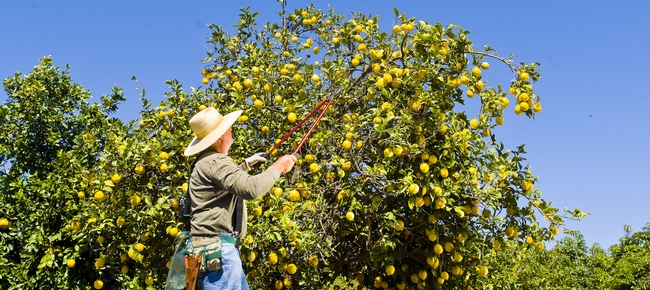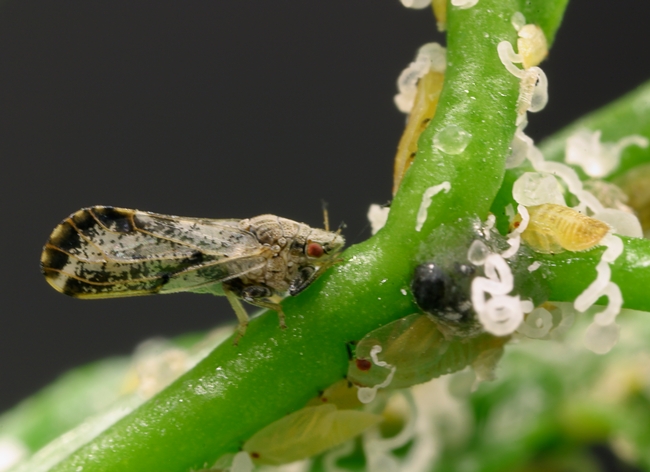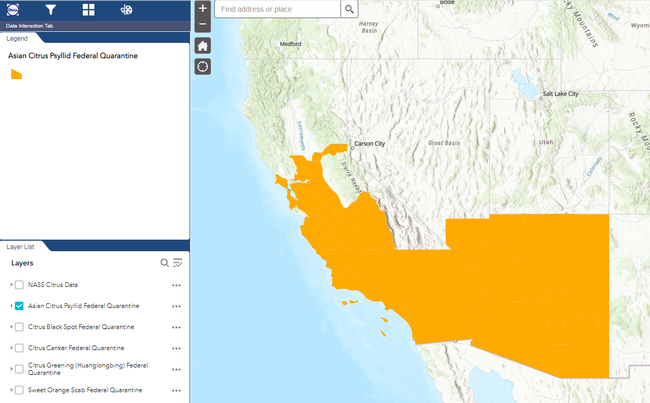Posts Tagged: ACP
The Twisitng Turns of HLB and ACP
Greening Bacterium Causes Changes in Psyllids
Recent studies, including a partnership project between Fundecitrus and the University of California, revealed that the citrus greening bacterium Candidatus Liberibacter asiaticus causes physiological changes in psyllids, posing additional challenges to management strategies. An increase in the number of eggs, more frequent dispersal flights over longer distances and greater attractiveness to the host are some of the changes observed in infected psyllids.
MORE DIFFICULT TO MANAGE
“Epidemiologically speaking, the changes we have been observing in psyllid behavior turn it into a much more problematic insect,” said Fernando Amaral, Fundecitrus agricultural engineer and post-doctoral student at the São Paulo University Luiz de Queiroz College of Agriculture.
The psyllid behavioral changes hinder the development of pheromone tools to attract the insect and improve its monitoring.
“It is becoming increasingly clear that the psyllid undergoes several changes, and this phenomenon not only poses difficulties to management, but also curbs the development of products to capture the insect,” added Fundecitrus researcher Haroldo Volpe.
Studies published between 2015 and 2024 revealed that psyllids infected with the greening bacteria can lay up to 100% more eggs than healthy insects, contributing to the growth of the psyllid population.
FREQUENT FLIERS
The studies also concluded that infected psyllids are more agitated when compared to healthy insects. In order to reach this conclusion, researchers placed adult insects from both groups on a platform. The teams noticed that infected insects flew, on average, after 50 seconds from the beginning of the observation period. The healthy subjects took around 150 seconds.
“Knowing that the insect flies more often and starts flying earlier demonstrates agitation and altered behavior, increasing its ability to spread greening,” said Volpe.
Yet another conclusion of the studies is that infected psyllids perform more frequent dispersal flights.
“Psyllids infected with the greening bacteria have a 45% higher rate of long flights when compared to healthy insects,” said Amaral.
In other words, the infected psyllid will fly longer distances and further spread the disease. Moreover, infected psyllids will also have a greater need to feed (forage) on more shoots and consequently will further disseminate the disease.
SUSCEPTIBILITY TO INSECTICIDES
On the other hand, the susceptibility of infected insects to insecticides is greater than that of healthy insects. Psyllids infected with the greening bacteria require a 20% to 313% lower concentration of insecticides to achieve the same mortality rate as healthy insects. This happens because the bacteria interferes with the psyllid metabolization of these products, which hinders their detoxication process.
CONTINUE COMBATING DISEASE
Fundecitrus General Manager Juliano Ayres emphasized the need for citrus growers to remain aware of the measures used to combat the disease in the field.
“The more diseased plants in groves without appropriate psyllid control, the more contaminated insects there will be and, consequently, the faster the disease will spread,” Ayres said. “Therefore, it is essential to continue to eliminate diseased plants from groves and keep up strict control of the insect on these plants.”
Source: Citricultor, Fundecitrus
CLas-Positive Psyllid Sample in Riverside County
July 26, 2024
An adult Asian citrus psyllid (ACP) sample from a residential property in the San Jacinto Valley area of Riverside County, California, has tested positive for Candidatus Liberibacter asiaticus (CLas), the bacterium that causes huanglongbing (HLB).
The positive sample was collected as part of the Multi-Pest Risk Survey on a residential property in Hemet. It was confirmed positive for CLas on July 17 by the Citrus Research Board's Jerry Dimitman Laboratory. Nymphs were also collected from the property and tested negative for CLas. This is the first confirmed CLas-positive adult ACP found in the San Jacinto Valley area.
An HLB quarantine zone will not be established as a result of this CLas-positive ACP detection. However, California Department of Food and Agriculture (CDFA) staff is conducting surveys and collecting samples from the property and all HLB host plants that are located within a 250-meter radius around the find, per the ACP/HLB Action Plan.
It is crucial that ACP populations continue to be controlled properly in order to stop HLB from spreading, advised California's Citrus Pest & Disease Prevention Program.
While CDFA is not requiring mandatory treatment for area commercial growers, those who wish to take proactive steps to protect their groves or who have additional questions can contact Riverside County Grower Liaison Sandra Zwaal.
In September 2023, a CLas-positive ACP sample was collected from a residential property in California's Ventura County. That sample came from a residential citrus tree in the southwest area of Santa Paula. An HLB quarantine zone was not established as a result of that detection, either. While that first confirmation of a CLas-positive ACP in Ventura County was concerning, HLB was not detected in any Ventura County citrus trees. Learn more here.
Source: Citrus Pest & Disease Prevention Program

acp lewis
Lawn-pocalypse! Surviving Drought
Ah, summer! The season of sunburns, pool parties, and… lawn droughts. If your once lush, green carpet now looks like a crunchy brown doormat, you're not alone. Let's dive into why your yard is staging a dramatic death scene and what you can do to...

Bermuda grass and weeds overtaking drought stressed turf grass.
Movento 24C renewed for Citrus in CA
Movento (spirotetramet) has been renewed for use on citrus Asian citrus psyllid in California. It's a foliar spray that is systemic especially moving to new tissue where ACP feeds. It also controls some other pests, such as thrips and leafminer. It has a short persistence effect on natural enemies and has low toxicity issues.
As an interesting aside, I just learned that cryolite (Kryocide, Pro-Kil) which was considered for organic registration at one time, has lost its registration. It was a stomach poison that worked on leaf-feeding beetles and lepidopteran pests like orange tortrix. The high level of fluoride necessitated its loss of registration.

Picture1
ACP News
HLB Update - Ventura County Detections
There have been no new confirmed positive HLB detections in Ventura since early February, and no recent expansions to the 5-mile HLB quarantine in place in the Santa Paula area. To see a map of the current HLB quarantine areas and other details of HLB detections throughout the state, updated weekly, please visit maps.cdfa.ca.gov/WeeklyACPMaps/HLBWeb/HLB_Treatments.pdf.
Visit Information for Citrus Growers/Grove Managers for the most up to date mitigation requirements for moving bulk citrus to, from, and within an HLB quarantine. Even if mitigation is not required, it is still required for growers to submit an ACP-Free Declaration Form to the applicable county agricultural commissioner's (CAC) office in advance. The ACP-Free Declaration Form has been updated to reflect these changes.
There have been no confirmed positive HLB detections or HLB quarantines in Santa Barbara county to date.
2024 Ventura County ACP-HLB Grower Meeting June 11 - In person or via Zoom
All are welcome. June 11th, 8:30am - 1pm at United Water Conservation District, 1701 Lombard Street in Oxnard, or on Zoom (Meeting ID: 833 1062 0864, Passcode ACPHLB). This meeting has been approved for 4 DPR CEUs (1.25 Laws, 2.75 Other). To receive CEUs you must attend in person and pre-register with DPR at https://cereported/courses/290. If you are not seeking CEUs, there is no registration required.
The full agenda is below.
Citrus Program Leadership Changes
The California Department of Food and Agriculture's (CDFA) Pest and Disease Prevention Division (CPDPD) has announced that as of May 14, 2024, Victoria Hornbaker, former director of the CPDPD, transitioned to her new role as the director of the CDFA's Plant Health and Pest Prevention Services (PHPPS) Division. David Gutierrez, branch chief of the CPDPD, will serve as interim director while a recruitment process is conducted to find a permanent hire for the role. Read Full Article Here
Citrus Pest and Disease Prevention Committee Meetings -- Webinar and In Person
All meeting agendas and eventually the minutes are posted at www.cdfa.ca.gov/citrus committee/. The 2023-24 schedule for the Full Committee is here, and the schedule for Subcommittees is here.
- Executive Subcommittee - June 26
- Finance Subcommittee - July 9
- Operations Subcommittee - July 10
- Outreach Subcommittee - July 17
- Full Committee - August 8
All meetings are free and open to the public to listen to or make public comment. Meetings are currently in person and accessible via phone and/or webinar. Links to register for and join meetings are included in agendas when posted.
For a list of all current committee members, click here.
Important ACP/HLB Documents and Resources
- CDFA Citrus Division website: https://www.cdfa.ca.gov/Citrus/
- Regulatory/Quarantine
oSign up for regulatory updates from the Citrus Pest and Disease Prevention Division at www.cdfa/signup-email-updates.
oInteractive map to find out how close you are to HLB detections.
oRegulatory requirements for moving bulk citrus: Information for Citrus Growers
oSummary of regulatory requirements in the event of an HLB detection in commercial citrus: citrusinsider.org/Regulatory-Flyer
oSanta Barbara County Ag Commissioner's Office
- General ACP/HLB
oInformation on the state ACP/HLB program including maps, quarantine information, and a signup option for email alerts: citrusinsider.org/
oBiology of ACP and HLB, detection maps and recommendations for monitoring, eradication and management: ucanr.edu/sites/acp/
oUC IPM recommendations for ACP insecticides
oVideo on Best Practices in the Field, available in English and Spanish
oEn español -- Spanish-only ACP/HLB presentation video presentation and audio-only recording.
- Research
oLatest Science Advisory Panel Report
oUC Ag Experts Talk presentations on management of various citrus pests and diseases are available for viewing here and here on YouTube.
oCitrus Research Board video presentations from webinar series and California Citrus Conference
oSummaries of the latest research to combat HLB: ucanr.edu/sites/scienceforcitrushealth/
oScience-based analyses to guide policy decisions, logistics, and operations: www.datoc.us
-------- FOR MORE INFORMATION, CONTACT
Cressida Silvers
CA Citrus Pest and Disease Prevention Program
ACP/HLB Grower Liaison
Ventura, Santa Barbara and San Luis Obispo Counties
805 284-3310 (phone or text)

ACP grower meeting june 2024
Citrus Care in the Sharing Season - Help Prevent the Spread of Asian Citrus Psyllid (ACP)
As gardeners, we're often generous with our garden's bounty. From sharing seeds and plant trimmings to the joy of gifting homegrown fruit and vegetables, gardening is as much about community as it is about growing plants. However, in this season of sharing, we must also remember our responsibility to prevent the spread of pests and invasive species to protect California's diverse ecosystem.
First detected in California in 2008, Asian citrus psyllid (ACP) has been a concern for both commercial citrus growers and home gardeners. ACP poses a significant threat to California's citrus trees, capable of spreading the deadly huanglongbing (HLB) disease, an incurable condition that eventually kills the tree.
Detecting ACP involves looking for a few key characteristics. ACP is a tiny, mottled brown insect about the size of an aphid. Adults are typically 3 to 4 millimeters long and are identified by their distinctive body shape, where the head is narrower than the body, and they hold their wings tent-like over their bodies. They are most active during warm temperatures, and you might notice them jumping or flying when disturbed. The nymphs, the immature form of the psyllid, are yellowish-orange and secrete white, waxy tubules from the back of their abdomen.
Additionally, ACP leaves telltale signs on citrus leaves, such as twisted or curled new leaf growth. They are sap-feeders, like aphids and mealybugs, so they produce honeydew which leads to the growth of sooty mold. Regularly inspecting your citrus trees, especially the new growth, is key to early detection of ACP.
Recent updates to the USDA's Plant Protection and Quarantine citrus map highlights areas that are generally infested with ACP and those which are not. This distinction is crucial for understanding the regulations and eradication efforts in different regions across the state. To find detailed quarantine information by county or zones, visit the California Department of Food and Agriculture (CDFA) ACP Regulation and Quarantine Boundaries website and maps.
Looking at the map pictured above, areas in the southern region of California, south of the Grapevine or San Gabriel and Tehachapi Mountain Ranges, and as far up the coast as Santa Barbara County are considered generally infested. The CDFA does not carry out eradication efforts for ACP in these areas. In areas north of the Grapevine, an ACP detection on a residential citrus tree would trigger an eradication response from the CDFA.
As we approach the holiday season, a popular time for gardeners to share budwood for grafting, it's crucial to understand the importance of not moving citrus planting material between quarantine areas. It is especially important not to move budwood or citrus from Southern California or the Bay Area into California's Central Valley.
To aid in this effort, UC Master Gardener Program resources are available to help educate you about identifying ACP and understanding the quarantine regulations. Here are some key actions you can take:
- Only purchase new citrus trees from reputable nurseries.
- Do not accept tree cuttings or budwood from friends or family.
- After pruning or removing a citrus tree, dry out the green waste or double bag it to help ensure the green waste is disposed of appropriately.
- Control ants in and near citrus trees with bait stations. Scientists have released natural enemies of ACP in Southern California to help keep the pest in check, but ants aid ACP in evading the natural enemies.
The UC Agriculture and Natural Resources ACP website offers an interactive map tool, biological control efforts, and an online calculator for the potential costs of using insecticides. Additionally, the Statewide UC Integrated Pest Management website provides free online training for gardeners and detailed Pest Notes on ACP and HLB disease. Remember, inspecting your citrus trees is vital to prevent the spread of ACP and HLB. If you suspect an infestation, contact the CDFA Exotic Pest Hotline at 1 (800) 491-1899 or your local county agricultural commissioner.
Let's continue to share the bounties of our gardens, but let's do so responsibly, keeping our citrus trees safe and healthy. Together, we can make a difference in the fight against ACP and HLB.



